Physical Address
304 North Cardinal St.
Dorchester Center, MA 02124
Examination of the patient should be performed before and after decongestion to fully evaluate the factors that contribute to nasal obstruction.
The nasal cycle is an alternating one; the total resistance in the nose remains constant. In patients with a fixed septal deviation and intermittent nasal obstruction, the interplay of the nasal cycle becomes evident; the sensation of obstruction frequently mirrors the congestion phase.
Compensatory bony and mucosal turbinate hypertrophy can be found in the patient with a septum significantly deviated away from the enlarged turbinate.
Even more so than with the full-transfixion incision, tip support is significantly weakened with an open approach to the septum.
Any tear in the elevated septal mucosal membrane is repaired with a 5-0 plain suture; if bilateral membrane rents are noted, not only should they be repaired, but an interposition graft of crushed cartilage should also be placed between the septal flaps to significantly decrease the chance of permanent perforation.
To decrease the potential for loss of dorsal or tip support, the surgeon classically preserves at least a 1-cm dorsal and 1-cm caudal septal segment, which has been termed the L-strut and is inclusive of the nasal spine. However, only the obstructing portions of the septum should be removed, unless grafts are needed.
After reskeletonization of the septum, all areas of the mucoperichondrial flaps that were elevated should be mattressed with a continuous 5-0 plain suture from anterior to posterior; instead of the popular straight Keith needle, a curved needle should be used to prevent injury to the turbinate mucosa.
According to the literature, approximately 20% to 30% of patients who undergo septoplasty find that their symptoms are not corrected adequately, but this can be less than 10% with optimal techniques and appropriate diagnosis.
Nasal packing does not provide a benefit to the patient and can cause pain or bleeding with removal.
Bulky, large internal nasal splits should not be routinely used because they cause rhinorrhea, plugging, and pain on removal. Because they are sutured only anteriorly, they provide no support to the septum, nor do they add to the approximation of the flaps posteriorly. Thin, pliable Silastic sheets can be used in patients with septal perforations, nasal trauma, or intranasal synechia.
The nasal septum serves many functions, including separation of the nasal airway into two distinct chambers, support of the nasal dorsum, and maintenance of the shape of the columella and tip. Traumatic deviation or developmental abnormalities of the nasal septum can lead to significant nasal airway obstruction and cosmetic deformity. Poor airflow can lead to impaired olfaction, impaired humidification and filtering of the passing air, and reduced oxygen inflow. Anatomic septal deviation can also lead to chronic sinus disease and may at times result in an external nasal deformity.
The septoplasty operation has evolved from simple cartilage manipulation to the current more complex procedures, which are often combined with surgery on the turbinates and valves. Septoplasty corrects structural deformities of the nasal septum to help relieve nasal obstruction. When combined with rhinoplasty, the procedure may help to straighten the deviated nose and may provide cartilage grafts. Septoplasty is also performed in patients with a history of severe epistaxis caused by septal varices that develop from anterior cartilage deviation and the secondary interruption of lamellar airflow with resultant drying and irritation of the mucosa.
Development of the nasal airway begins during the fourth week of gestation. Collections of neural crest cells undergo proliferation and form the nasal placodes. On the fetal face, adjacent cells proliferate and give rise to the medial and lateral nasal processes. The frontal and maxillary processes fuse to give origin to the lateral two thirds of the upper lip, the superior alveolar ridges, and the palatal shelves. The medial nasal processes join the maxillary processes to form the philtrum and columella; they also fuse with the frontal prominence to form the frontonasal process, which eventually encompasses the nasal bones, the frontal bones, the cartilaginous nose, the ethmoid bones, the central incisors, and the hard palate. As the medial and lateral nasal processes grow, two nasal pits form that invaginate until only the nasobuccal membrane remains. This membrane eventually ruptures by the tenth week, thereby allowing communication between the nose and the nasopharynx.
The nasal septum develops as a downgrowth from the merged medial nasal processes and the nasofrontal process and thus defines the right and left nasal cavities. The nasal septum and the palatine processes begin to fuse anteriorly during the ninth week, and fusion is completed posteriorly by the twelfth week.
During the late embryonic period, the epithelium invaginates on each side of the nasal septum, thereby forming diverticula known as the vomeronasal organs . A vomeronasal cartilage develops ventral to each diverticulum. Shortly before birth, the vomeronasal organs begin to regress and usually disappear completely; the vomeronasal cartilages are usually the only adult remnants. These narrow strips of cartilage are located between the inferior edge of the cartilage of the nasal septum and the vomer. They are often found in conjunction with a septal spur, and they can be used as cartilage grafting material when other sources are absent or exhausted ( Fig. 29.1 ).
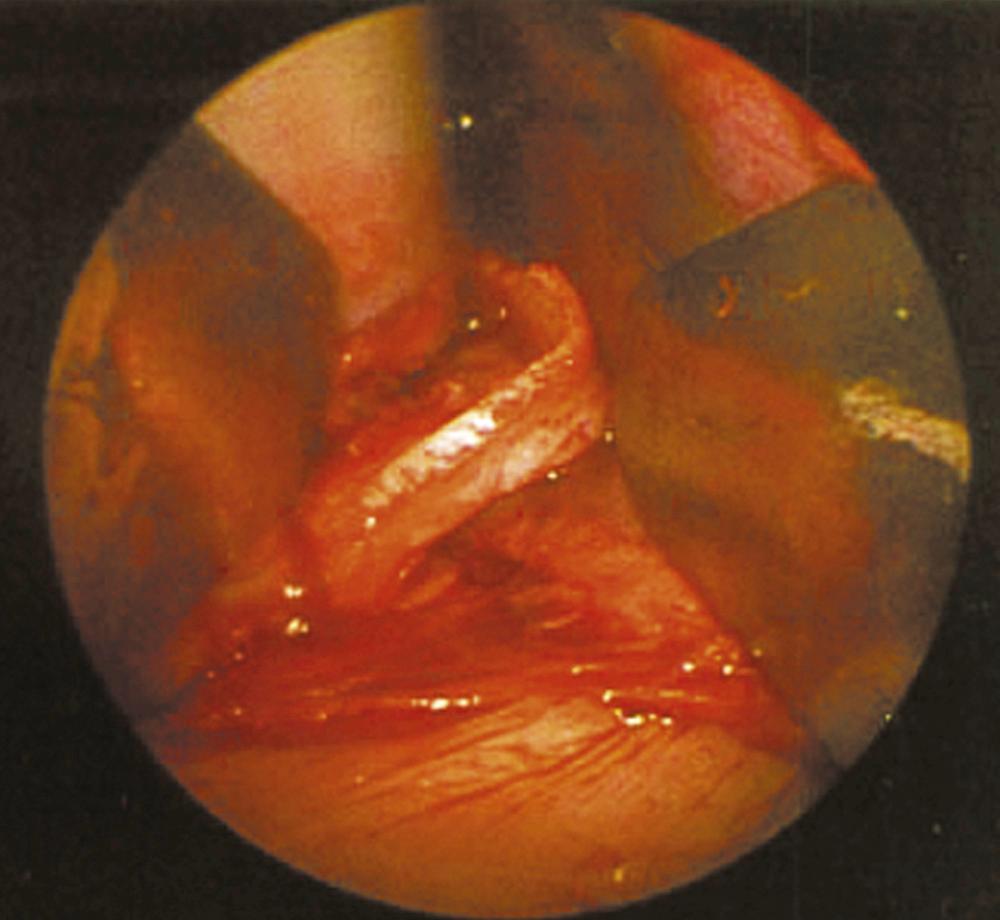
The cartilaginous framework of the nose develops from three paired mesenchymal condensations in both the medial and lateral nasal swellings. Part of this cartilage begins to ossify, thereby forming the membranous bone that encases the vomer and perpendicular cartilaginous plates. The perpendicular plates of the ethmoid and the nasal bones do not completely ossify until puberty. Injury to the nose in the young child or teenager may not elicit a true fracture, but it may instead create growth changes in this transitioning tissue that may ultimately result in a deviated posterior bony septum or even the formation of a spur.
The nasal septum has both functional and aesthetic significance. The septum is the main support structure of the external nose. It divides the nose into two cavities, regulates airflow through the nose, and supports the mucosal lining of the nasal cavities. Where once the lining was afforded greater significance, currently both the mucosa and the cartilage are recognized as codependent and necessary.
The bony components of the septum include the nasal crest of the palatine bone, the nasal crest of the maxilla and premaxilla, the vomer, the perpendicular plate of the ethmoid, the nasal crest of the frontal bone, and the spine of the paired nasal bones. The anterior septum is composed of the quadrilateral cartilage, with its caudalmost projection extending beyond the nasal spine. Because of the complicated embryologic development of the septum, any one of a number of arrangements of the bone and cartilage contributions may be encountered during surgery ( Fig. 29.2 ).
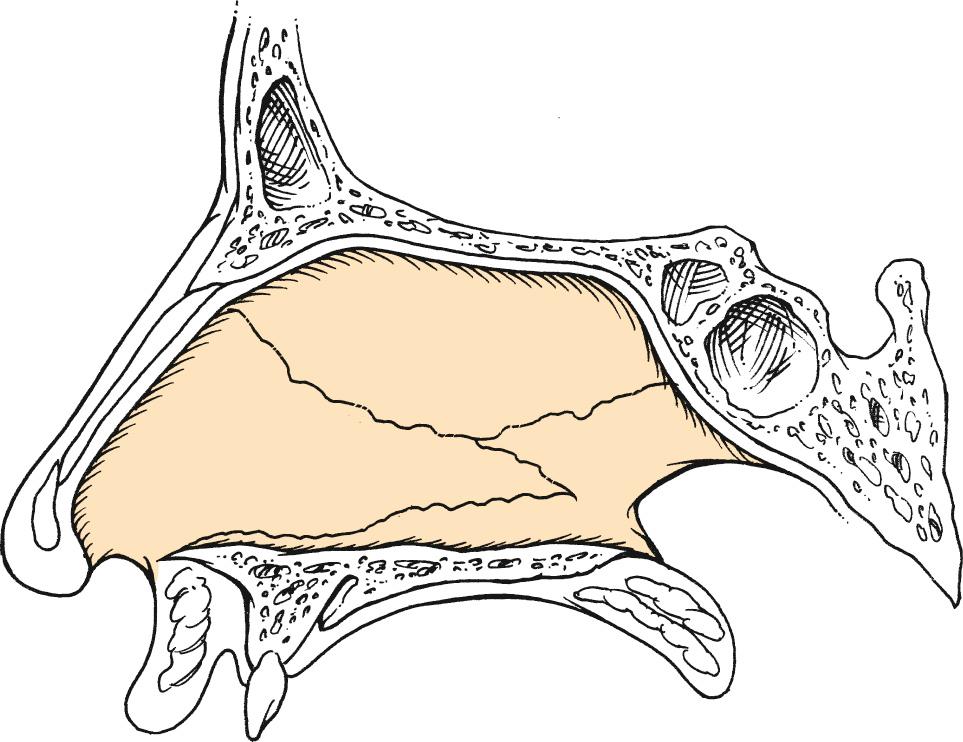
The lateral nasal wall is composed of the lamina papyracea of the lacrimal bone, portions of the ethmoid bone, and the inferior and middle nasal conchae or turbinates. The turbinate bones develop from a cartilage ossification center during the fifth intrauterine month. The inferior, middle, and superior turbinates are composed of a thin bone for structural support and are covered by an adherent mucoperiosteum. Stratified squamous epithelium is found on the anterior tip of the inferior turbinate, whereas pseudostratified ciliated columnar respiratory epithelium covers all other surfaces. The continually beating ciliated mucosa provides constant motion to the layer of mucus within the nose, which acts as a cleaning and filtering system for the upper respiratory tract and also helps to maintain the moisture content within the nose. The turbinates maximize the effective intranasal surface area and rapidly humidify and warm the inspired air.
Blood supply and innervation of the nasal septum exist within the mucoperiosteal and mucoperichondrial linings. The arterial blood supply originates from the ophthalmic branch of the internal carotid artery and the maxillary and facial branches of the external carotid artery. Blood to the upper nasal septum is supplied by anastomoses of the anterior and posterior ethmoid arteries, which originate from the ophthalmic branch. The external carotid artery contributes via a major branch of the sphenopalatine artery that perfuses the posterior and inferior septum. The columella and caudal septum receive blood supply from the septal branch of the superior labial artery. The septal mucosa itself contains complex arteriovenous anastomoses and venous sinusoids that can become engorged or constricted via neural or extrinsic pathways.
A variably located incisive artery and its associated neural fibers are found at the inferior border of the vomer. This neurovascular bundle may be encountered when trimming a badly deviated maxillary crest, or when elevating periosteum when a nasal floor approach is needed. Control of bleeding from this site may be obtained by infiltrating the incisive foramen from below, “plugging” the site from above, or carefully using suction cautery. After resection or trimming of the maxillary crest or work on the nasal spine, patients may complain of numbness or pain of the central incisors or of the mucosa of the hard palate just posterior to the incisors. This lack of sensation or complaint of pain is generally a short-lived phenomenon ( Fig. 29.3 ).
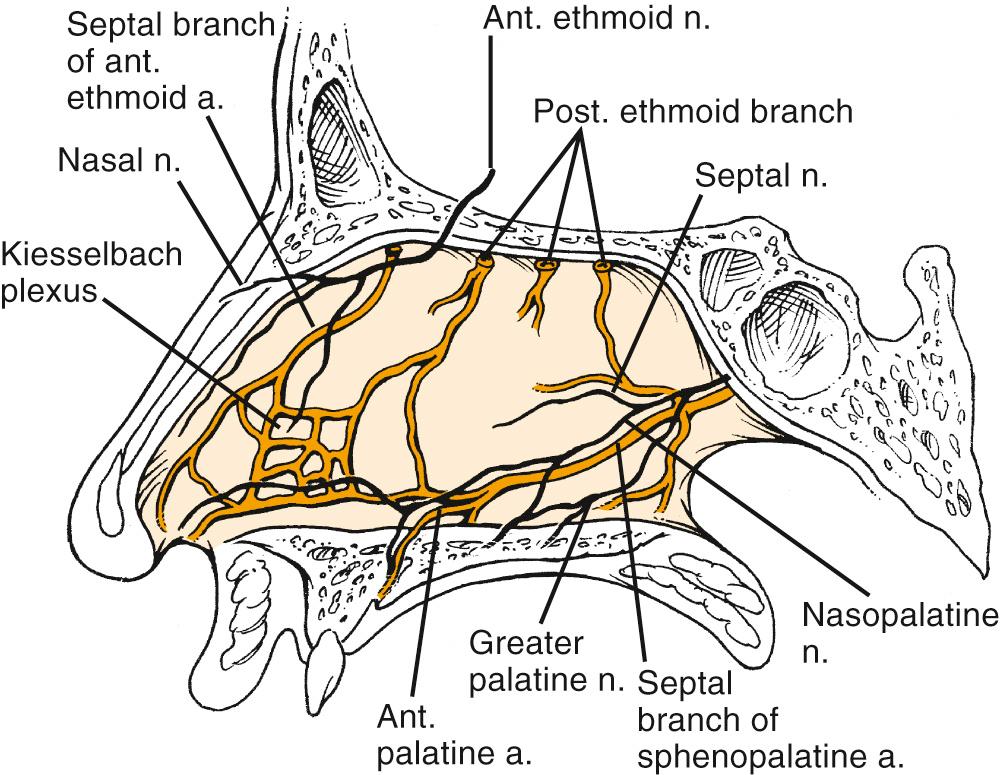
Innervation of the nasal mucosa includes both autonomic and sensory components. The autonomic nervous system regulates the degree of vascular tone, turbinate congestion, and nasal secretions present in the nose at any given time. Presynaptic parasympathetic fibers travel along the facial nerve and continue as the greater superficial petrosal nerve at the geniculate ganglion. These fibers then join the deep petrosal nerve to form the vidian nerve. Within the vidian nerve, the fibers travel to the sphenopalatine ganglion and synapse with the postganglionic neurons before innervating the nasal mucosa. Postsynaptic sympathetic fibers pass through the sphenopalatine ganglion and terminate in the nasal mucosa. The first and second divisions of the trigeminal nerve supply sensory innervation to the nasal mucosa. Trigeminal nerve fibers also pass through the sphenopalatine ganglion and transmit sensations of pain, temperature, and touch.
Thorough examination and visual inspection of the patient who complains of nasal airway obstruction are essential for diagnosis and treatment planning. Visual assessment of the external appearance of the nose is of utmost importance. This examination initially focuses on the size, shape, symmetry, and straightness of the nose. Because septoplasty will correct airflow only if air can get into the nose, the surgeon should document the size of nostril openings, the thickness of the alae, and the width of the columella. Columellar widening may be seen with caudal septal cartilage deviation, splaying of the medial crura, or excess soft tissue. A previously fractured nose can hold the dorsal septum off the midline, and no septoplasty alone can correct this problem ( Fig. 29.4 ). Such routine situations require sharply freeing up the septum from the upper lateral cartilages (ULCs) and performing medial osteotomies and a septoplasty with release of the septum from the maxillary crest for correction. Deformity of the nasal vault can narrow the diameter of the nasal passage. The patient with a crooked or C -shaped nose often has a severely deviated septum as well. Before examining the nose internally, the physician must observe the patient's nose during normal and exaggerated nasal breathing, watching the side walls for evidence of internal or external collapse ( Fig. 29.5 ). However, care must be taken when assessing the chronic sniffer or “nasal neurotic,” who will show collapse as a result of an overly aggressive inspiratory force being generated, regardless of the competency of the valve. Surgery for the chronic sniffer will generally lead to poor outcomes despite adequate anatomic support and deflection correction. Care of this patient will often include frequent postoperative phone calls and second opinions obtained with regard to his or her problem, which is still perceived as uncorrected.
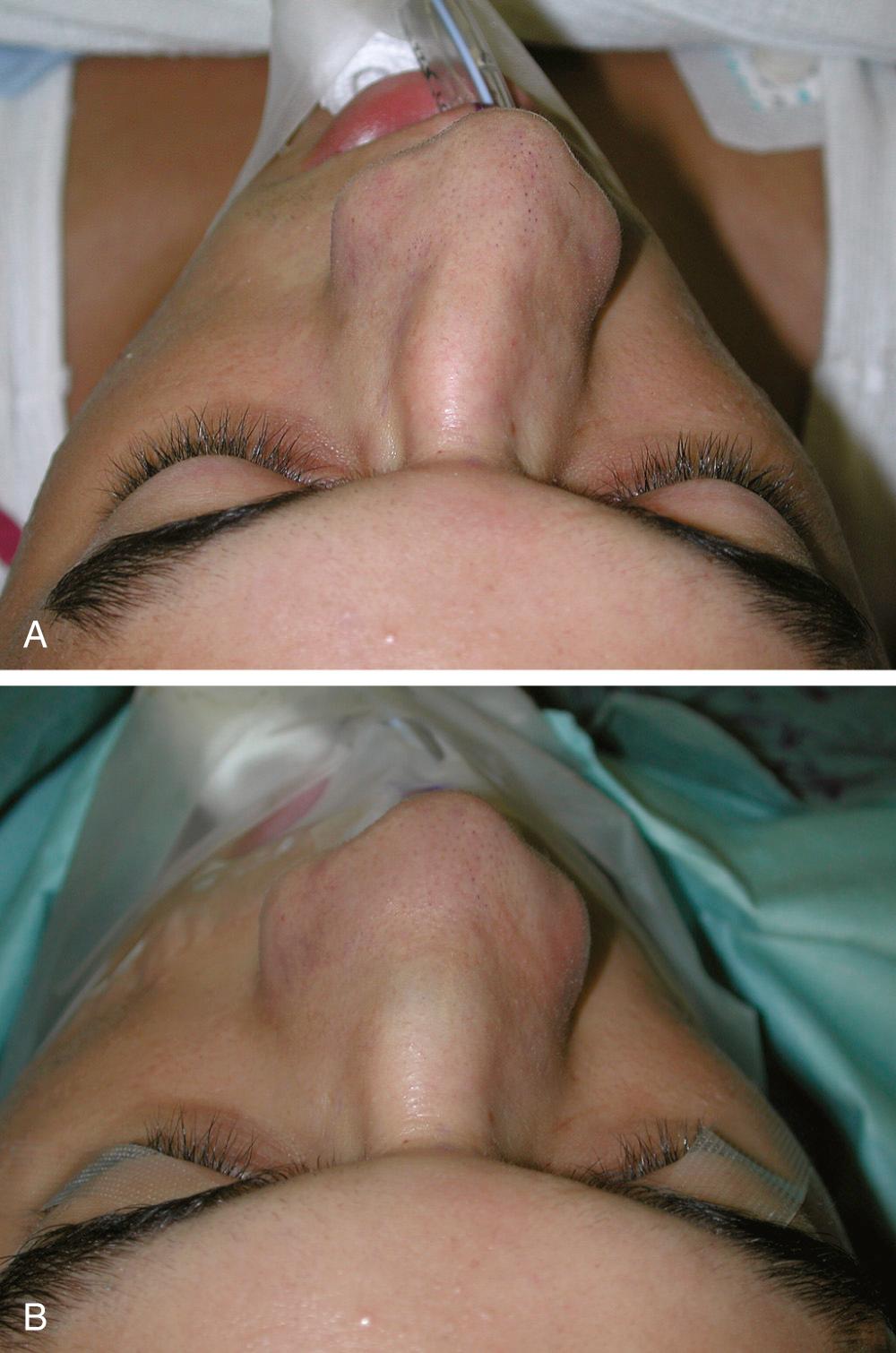
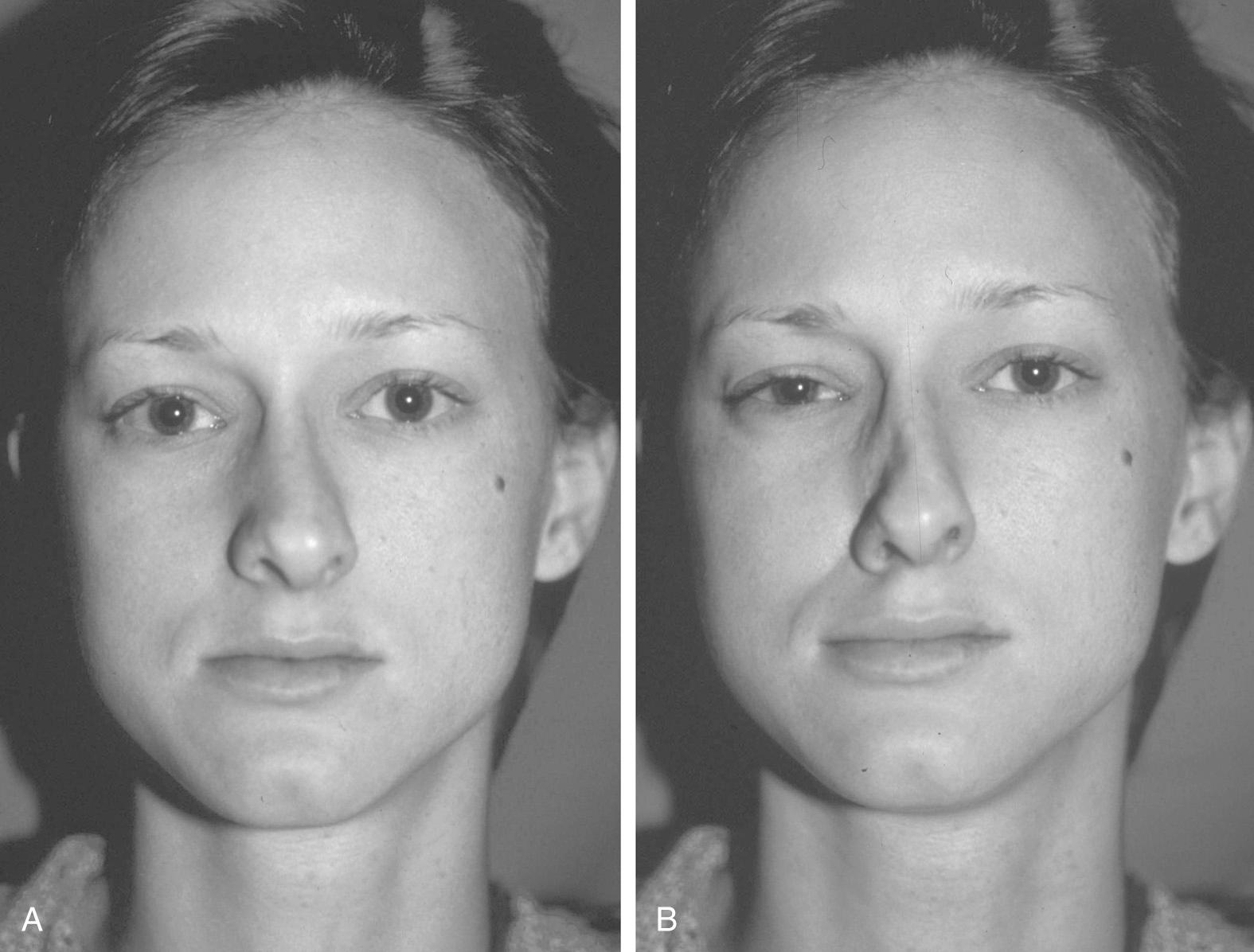
Anterior rhinoscopy allows for visualization of the septum, the turbinates, and the nasal valve—the most narrow area of the airway, bordered by the septum, the ULC, and the anterior aspect of the inferior turbinate. Examination of the patient should be performed before and after decongestion to fully evaluate the contributing factors to nasal obstruction and to allow for a complete nasal examination because a hypertrophic turbinate can often obscure a posterior nasal spur. There should be no surprises at the time of surgery as a result of inadequate preoperative problem recognition. The surgeon should fully evaluate the nasal cavity, taking care not to miss high septal deviations, which can impinge on the internal nasal valve as well as be more complex to address. Nasal endoscopy with a rigid endoscope of the sinonasal region can be carried out to fully evaluate intranasal structures and assess for polyps, masses, and adenoidal size.
External evaluation of the patient's nose should also include evaluation of the internal nasal valve. A positive Cottle maneuver may suggest nasal valve compromise. However, the maneuver is not always a reliable indicator, with many false-positive results because of the large mass movement. Gentle lateralization of the ULC with a cotton-tipped applicator, a cerumen curette, or similar instrument is a more specific maneuver to increase the internal nasal valve angle and, in those with a narrow angle, to improve airflow and reduce the sensation of nasal obstruction ( Fig. 29.6 ). In addition, tip ptosis can contribute to nasal obstruction by preventing adequate airflow into the nasal airway ( Fig. 29.7 ).
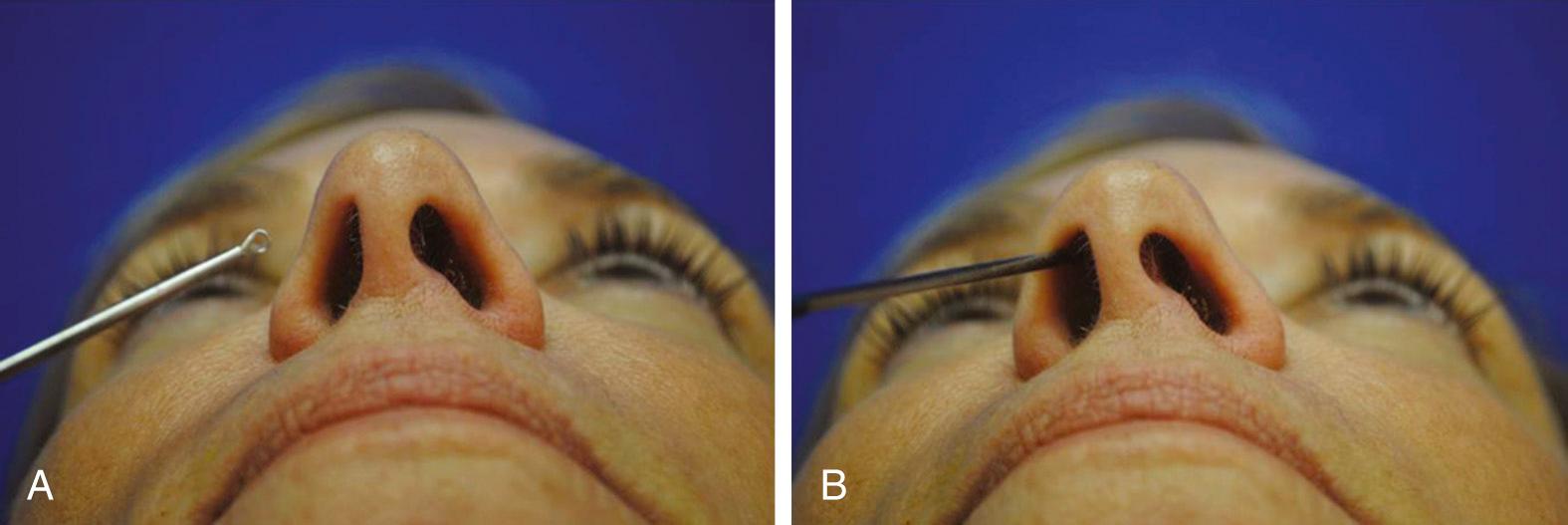
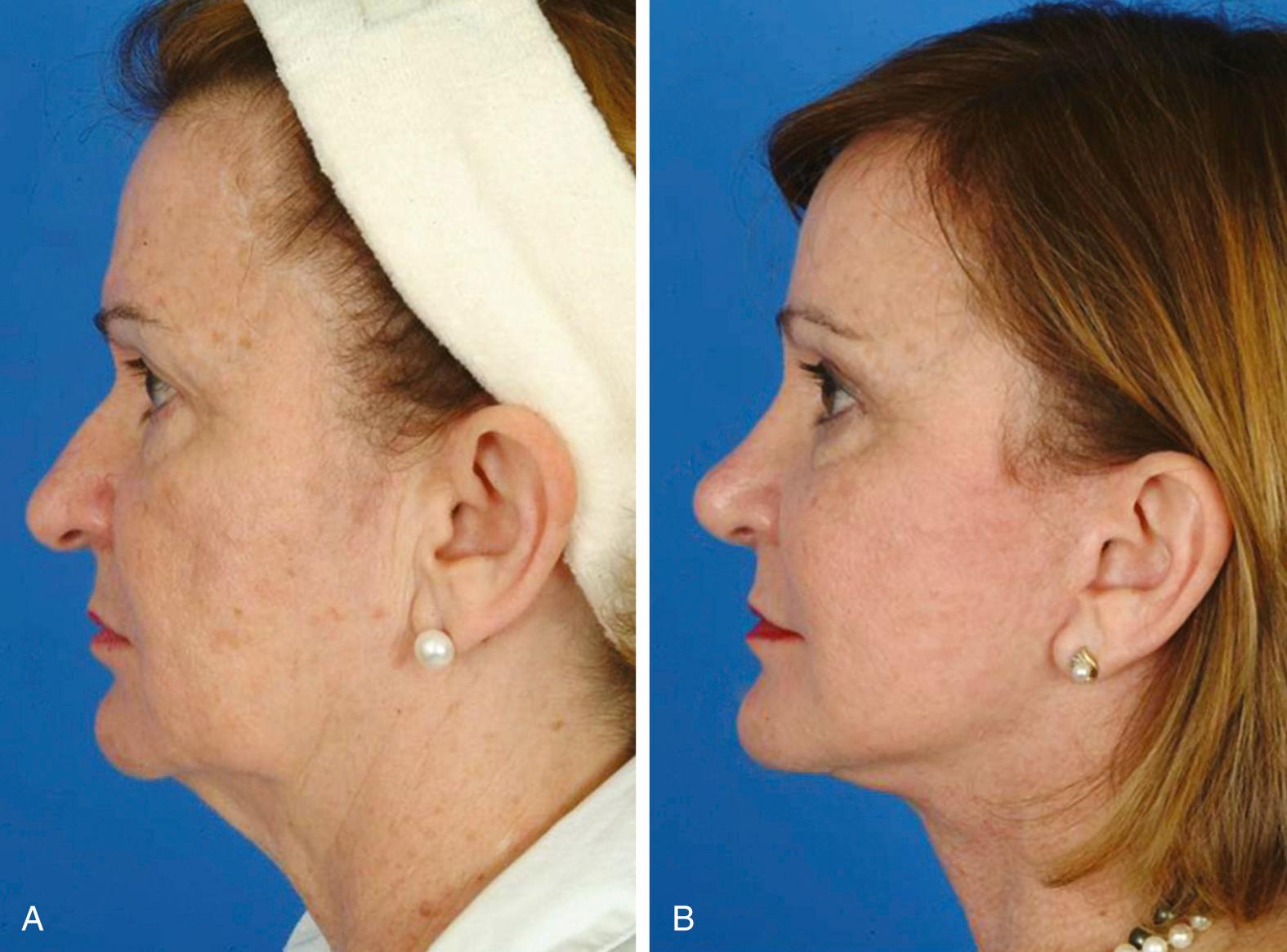
Deviation of the nasal septum is a common cause of unilateral nasal airway obstruction and may follow nasal and midfacial trauma. Trauma during birth, including forceps placement or passage through a narrow pelvic canal, can cause injury that may lead to early septal deviation or to deviation that is not evident until the more active growth phase of puberty. Minor trauma sustained early in life can be easily overlooked and frequently causes microfractures of the septal cartilage; healing of these microfractures leads to bending of the cartilage away from the side of injury. When this occurs early in life, it may lead to asymmetric growth of the entire nasal structure as a result of chondrocyte growth interruption. Patients with unilateral septal deviation may complain of nasal obstruction on the contralateral side, perhaps as a result of turbinate prominence, a phenomenon called paradoxic nasal obstruction. Patients are confused when the physician explains that the nasal passage through which the patient feels airflow moves most freely is actually the smaller of the two sides. Decongesting the nose and then testing airflow through each nostril separately or showing the patient an endoscopic image of each passage can help the patient to accept the explanation and understand the true problem.
The internal nasal valve is the narrowest portion of the nasal cavity and therefore any compromise of the components of the valve creates symptoms of nasal obstruction. The angle is bound medially by the septum and laterally by the inferior edge of the ULCs and the anterior aspect of the inferior turbinate; this junction forms a trapezoidal configuration ( Fig. 29.8 ). This angle widens with muscular contraction and narrows with negative pressure on inspiration. The nasal valve is normally 10 to 15 degrees in white patients and wider in nonwhites. Deformities of the adjacent nasal septum or loss of anatomic support structures can predispose the valve to collapse or narrowing, thereby causing nasal airway obstruction. At its junction with the septum, the ULC may be thickened, twisted, or concave as a result of weakness or trauma, or it may be displaced or even absent if surgery was done previously. Webs of scarred mucosa may form between the septal mucosa and the lateral nasal wall or turbinates and may narrow the valve through scar contracture ( Fig. 29.9 ). Adhesions that result in valve narrowing can create a fixed obstruction with a false-negative Cottle maneuver.
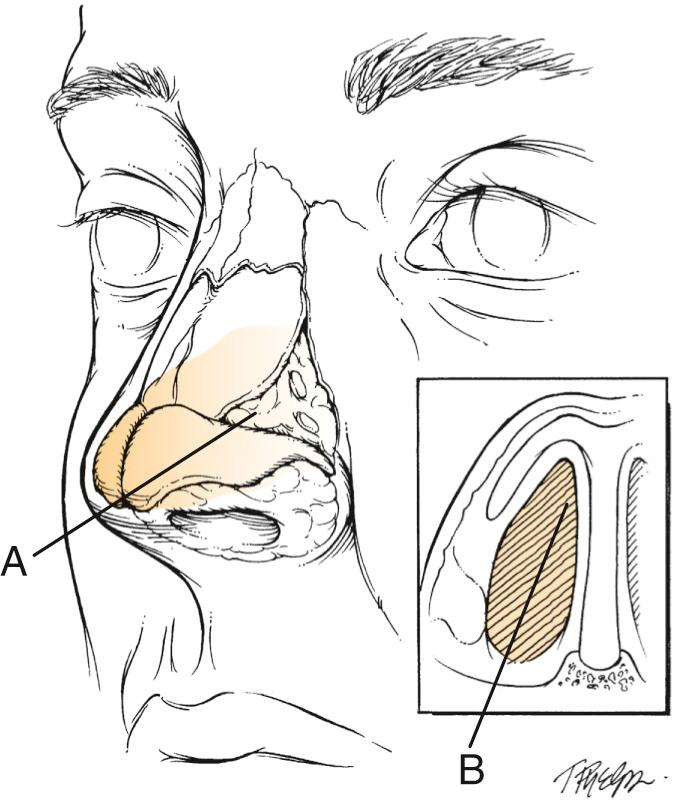
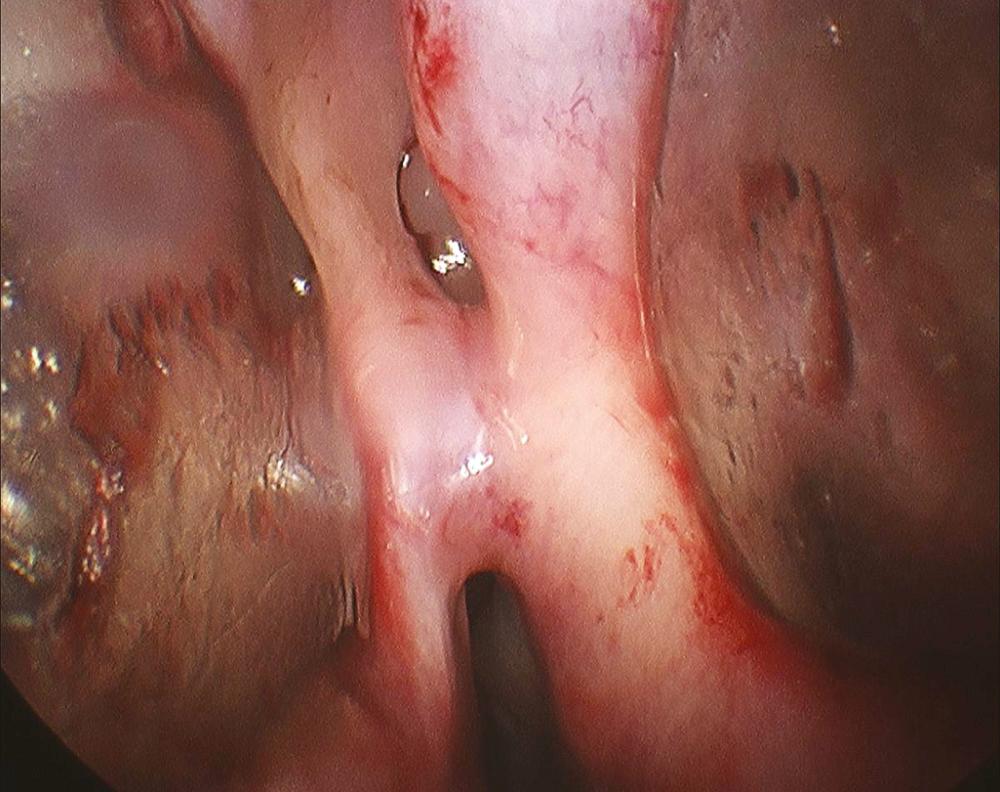
The external valve is a laterally based area of soft tissue boxed by the piriform aperture, the ULC and lower lateral cartilage (LLC) attachments, and the septum. Obstruction as the result of external valve compromise is from weakened or lacking cartilage from rhinoplasty, caudal septal dislocation, trauma, or lax connective tissue as a result of the aging process. Alar batten grafts have been shown to correct both internal and external nasal valve collapse in patients without scarring.
On inspiration, the airstream funnels through the vestibule of the nose, squeezes through the narrow valve, and disperses in the nasal cavity. Cadaver studies indicate that flow through the nasal valve of an adult at rest is accelerated to a linear velocity of 16 m/s. As the airstream leaves the valve and enters the nasal cavity, its velocity decelerates by a factor of 4; this deceleration promotes disruption of the air by allowing it to mix in the nasal cavity. This is essential for the effective conditioning of inspiratory air and may aid in the ability to smell. Conditioning consists of humidification, removal of antigenic particles, and warming.
Resistance to airflow refers to forces that impede the flow of air through a conduit. Nasal resistance is evaluated by simultaneously measuring nasal airflow and the resultant pressure gradient in the nasopharynx. Ohm's formula integrates these measurements to calculate nasal resistance in centimeters of water per liter per second (or Pascals/mL/s).
The single most important variable in nasal airflow is the diameter of the nasal passage. Dimensions and shape of the airway lumen and airflow velocity determine the magnitude of resistance to airflow. Resistance varies inversely and exponentially with lumen cross-sectional area, and because the nasal valve has the smallest lumen dimension, nasal valve resistance is very sensitive to structural narrowing. In healthy noses, resistance to airflow is reduced by a third after topical decongestion, and resistance of the decongested nose is reduced by two-thirds with wide alar retraction.
Nasal resistance is modified and controlled physiologically by the erectile tissues of the nasal mucosa. The parasympathetic system controls the congestion and increases nasal secretions by vasodilation of the sinusoids and capillaries in the mucosa, whereas the sympathetic system provides a steady vasoconstrictor tone. Nasal obstruction can be felt not only as an actual decrease in the nasal diameter but also as a feeling of obstruction, even when no anatomic obstruction exists. Eliciting a medical history is clearly important because certain medicines (e.g., exogenous hormones, oral contraceptives) can alter the neural input to the mucosa and result in mucosal hypertrophy and nasal obstruction. Turbulent airflow creates a perception of increased resistance and prevents proper clearance of air volume. In patients with severe nasal septal deviation or with septal perforations, airflow is turbulent. The nose interprets turbulent flow as low flow and thus creates a sensation of stuffiness for the patient.
The nasal cycle was first observed in 1927 by Heetderks, who described alternating turgescence of the inferior turbinates in 80% of a normal population. The turbinates in one fossa filled up, while the opposite turbinates decongested. This cycle, which is controlled by the autonomic nervous system as described earlier, had a mean duration of 2.5 hours. Heetderks further observed and documented that the turbinates in the dependent nasal fossa filled when the patient was in the lateral decubitus position. Some postulate that this alternating positional obstruction has the purpose of causing a person to turn from one side to the other while sleeping. The nasal cycle is an alternating one, with the total resistance in the nose remaining constant. In patients with a fixed septal deviation and intermittent nasal obstruction, the interplay of the nasal cycle becomes evident; the sensation of obstruction frequently mirrors the congestion phase.
Some patients with a severely deviated septum learn to subconsciously eliminate the steady state increased resistance sensation of the obstructed side. The opposite or normal side has a variable resistance as a result of the continued fluctuations of the nasal cycle. Nasal obstruction will be perceived on the nondeviated septal open side during the turgescent phase; this phenomenon is known as paradoxic nasal obstruction . Knowledge of this phenomenon is essential to avoid misinterpretation of the significance of unilateral enlargement of one inferior turbinate, which is often present in normal noses. Surgical correction must address the deviated septum, but it must also address the etiology of the patient's subjective complaint of increased resistance on the side on which clinical evaluation shows a more open nasal passage, and it may necessitate a turbinate procedure.
The dynamic portions of the nose—including the nostrils, vestibules, and lumen—can be narrowed as a result of the Venturi effect (see Fig. 29.5 ). Identification of collapsible nasal structures is important and should be addressed during preoperative review. Surgery can then be planned to widen the angle between the ULCs and the septum with spreader grafts or to stiffen the nasal side wall with batten or umbrella graft placement.
Become a Clinical Tree membership for Full access and enjoy Unlimited articles
If you are a member. Log in here